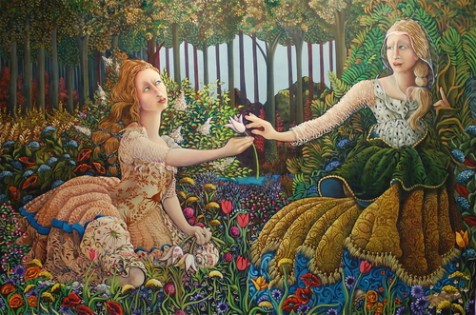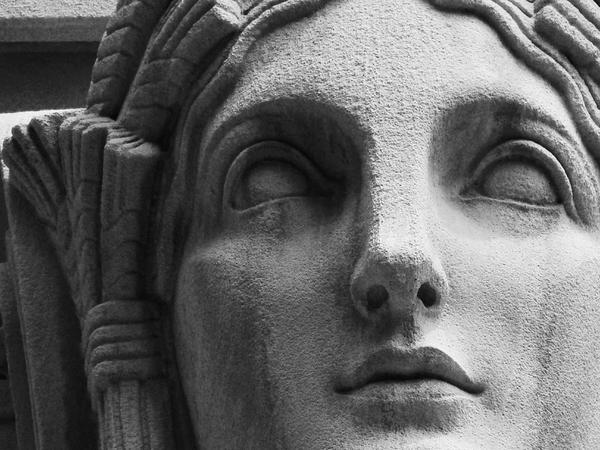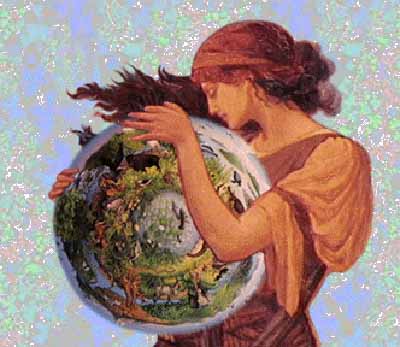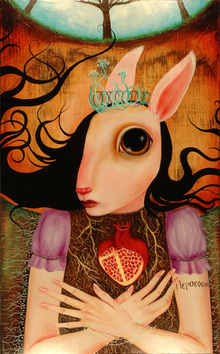The Eleusinian Mysteries (Greek: Ἐλευσίνια Μυστήρια) were ceremonies
held every year for the cult of Demeter and Persephone based at Eleusis
in ancient Greece. They were practiced at this autumnal equinox time of the year.
They were religious practices characterized by initiation rites, cathartic and ecstatic practices, and a code of silence.
These myths and mysteries were the most famous and begun in the Mycenean period (c. 1700 BC) and lasting two thousand years, were a major festival during the Hellenic era, later spreading to Rome.
The rites, ceremonies, and beliefs were kept secret, as initiation was believed to unite the worshipper with the gods and included promises of divine power and rewards in the afterlife.
Since the Mysteries involved visions and conjuring of an afterlife, some scholars believe that the power and longevity of the Eleusinian Mysteries came from psychedelic agents.
Eleuseos means “the coming,” so the word Eleusinian refers to a spiritual advent.
Mysteria signified an event defined by closing the lips, closing the eyes, and entering into darkness.
The journey of consciousness taken from that point onward was a mystery indeed.
Long ago, humans felt a deep need to celebrate and honor times of
sowing, reaping and harvest, keenly aware that, should anything untoward
negatively affect nature's cycle, many people - perhaps all - would die
in the ensuing famine. For instance, this day, 20 September, in ancient
Greece, would have marked the 7th day of the Eleusinian Mysteries:
revered initiation ceremonies held every 4 or 5 years (sources vary),
lasting 9 days, honoring Demeter the Mother Goddess of agriculture and
fertility, and Persephone, Queen of the Underworld.
Persephone was the daughter of Demeter, goddess of agriculture and
grain. She was stolen away to the realm of death by Hades, king of the
underworld, who had seen her and fallen in love(major clue here: in some earlier versions, Hades is called Pharmacia.)

No-one could tell
Demeter where Persephone had vanished to, so Demeter wandered the world
with Hecate, goddess of childbirth and secrets who carried two torches,
seeking her daughter and refusing to let anything grow until she had
Persephone back. Hecate finally found Persephone.

But Persephone had in hunger nibbled four pomegranate seeds, and the Fates decreed that since she ate the food of Hades in the underworld she must stay. Demeter would have let the world starve, but instead a compromise was arranged where Hades would have Persephone for the four months of winter (when no crops would grow) and Demeter for the rest of the year. (Anglocentric retellings changed this to six seeds and six months to accommodate the longer northern European winter.)

But Persephone had in hunger nibbled four pomegranate seeds, and the Fates decreed that since she ate the food of Hades in the underworld she must stay. Demeter would have let the world starve, but instead a compromise was arranged where Hades would have Persephone for the four months of winter (when no crops would grow) and Demeter for the rest of the year. (Anglocentric retellings changed this to six seeds and six months to accommodate the longer northern European winter.)

The Mysteries originated in the city of Eleusis, 15 miles west of Athens, possibly as far back as the early Mycenaean period (c.1600 B.C), and continued for almost two thousand years, in a world both alien yet oddly familiar to us, in the twenty-first century. Theirs was a world permeated with anxiety and dread, perhaps not unlike that of the USA after 9/11, or during the Cold War years.....or right now! Famine was, for them, a persistent threat. A single crop failure could spell the difference between life and death. The risk of war, whether from marauding bands or organized armies, was constant. Death or slavery awaited the losers of a conflict. Family provided the only social safety net for most. People lived constantly on the edge of disaster.

The long drawn-out structured rituals of the Mysteries produced a change of consciousness in the participants bringing about a kind of spiritual birth, intended to reunite the person with the divine spirit of the cosmos. The rites, ceremonies, and beliefs were kept strictly secret. Since The Mysteries involved visions of an afterlife, some scholars believe that the power and longevity of the Eleusinian Mysteries came from psychedelic agents.

Before experiencing the final soul-shattering vision of the Greater Mysteries, initiates drank kykeon, an entheogenic potion made from ergot, from which LSD is derived. The initiates then spent the night in a darkened hall, where they beheld a great vision, which was “new, astonishing, inaccessible to rational cognition.” Most of the initiates were women, but men (including Sophocles, Aristides and Cicero), as well as slaves (anyone who could afford it was allowed except for unrepentant murderers), also took part. Whatever the vision, there is no doubt that the effects were profound. Some hold that a night in the Eleusinian sanctuary may have inspired Plato's “ideas” and world of archetypes. In times much closer to our own, ingesting similar potions inspired the composition of iconic music and song.
"Those who take part possess better hopes in regard to the end of life and in regard to the whole of eternity.' - Isokrates
So the Eleusinian Mysteries drew to an end. After the Final Vision the Initiates partook of one more day of the Rites, this time involving food, drink and celebration in honour of the abundance and fertility of Demeter - the Gift of the Grain. Thus after Death had been faced and transcended the bounty of Nature was rejoiced in. After that, the Mystai were free to return to the world, their understanding of their place in it transformed...

Why are the Eleusinian Mysteries so important to us? For the Greeks, as we have seen, they were crucial: the axis, as it were, around which the Universe of Gods and Men revolved. For two thousand years (as long as Christianity has been on this Earth and longer than Islam) they performed this vital role for Greek culture, only being discontinued several centuries after Christianity had become the official religion of the Roman Empire.

What makes the Rites of Eleusis important is their influence on almost all the Mystery Traditions that followed them. In their exploration of Immortality and their focus on imagery of grain and corn they almost certainly found their way into the New Testament. We have seen how the iconography of corn is used in the Gospel of John, for instance and, of course, there are other such images in parables such as that of the sower of seed. Historians of religion have done a great deal to unearth how all sorts of pre-Christian Mysticism worked its way into the Gospels. We forget how at the time of Christ's birth and ministry nearby Alexandria was a focus for spirituality in the known world at the time. Alexandria was a centre for Jewish religion and mysticism, Zoroastrianism, Platonic, Pythagorean and Hermetic spirituality and the old Egyptian Mysteries. It should come as no surprise that the new spirituality of Christianity should encounter and absorb these traditions. One can see that it became a synthesis of all that came before embodied in the human/divine figure of Christ. Whatever the case there would seem to be no doubt that the Mysteries of Eleusis found their way into the new religion. Taken with the Mysteries of Dionysus and their imagery of the Vine, those of Eleusis reappear in the bread and wine of the Last Supper.
As an image of the life-giving energy of the Divine Feminine, the Mysteries found themselves reworked in a complex way in the figures of the Virgin Mary, Mary Magdelene and the Sophia. And just as the Eleusinian Final Vision took place in the Inner Sanctum, Christ's Resurrection, witnessed by the Persephone counterpart Mary Magdelene, takes place in the Tomb which is itself an image of the Womb of the Divine Mother. Thus the life-giving energy of the Divine Feminine is inextricably associated with the Resurrection of Christ all of which, the two Marys, the Shekhinah, become expressions of the Wisdom of God, the Sophia. Without her and the energies she represents, the central miracle of the Christian Mysteries cannot happen.
 In
esotericism, the Rites appear vividly in the Empress Card as depicted in the
Rider-Waite pack. Waite's Empress is pure Demeter-Persephone. Her robe
is covered in pomegranates, associated with the Daughter while at her
feet is the wheat of the Mother. Also associated with Demeter is the
diadem of stars the Empress wears. In astrology, Virgo is linked to the
Mysteries, being often represented as maiden carrying a sheaf of corn in
each hand. People who have been on the ball will have noticed that the
ten days of the Rites fell during harvest time, the period we associate
with September, the month of Virgo. Thus they would have been presided
over by this constellation which rules the ninth month, nine months
being, of course, the nine months of gestation before birth. So all
these images of femininity, fertility and fecundity all merge into one.
In
esotericism, the Rites appear vividly in the Empress Card as depicted in the
Rider-Waite pack. Waite's Empress is pure Demeter-Persephone. Her robe
is covered in pomegranates, associated with the Daughter while at her
feet is the wheat of the Mother. Also associated with Demeter is the
diadem of stars the Empress wears. In astrology, Virgo is linked to the
Mysteries, being often represented as maiden carrying a sheaf of corn in
each hand. People who have been on the ball will have noticed that the
ten days of the Rites fell during harvest time, the period we associate
with September, the month of Virgo. Thus they would have been presided
over by this constellation which rules the ninth month, nine months
being, of course, the nine months of gestation before birth. So all
these images of femininity, fertility and fecundity all merge into one.
So the Eleusinian Mysteries drew to an end. After the Final Vision the Initiates partook of one more day of the Rites, this time involving food, drink and celebration in honour of the abundance and fertility of Demeter - the Gift of the Grain. Thus after Death had been faced and transcended the bounty of Nature was rejoiced in. After that, the Mystai were free to return to the world, their understanding of their place in it transformed...

Why are the Eleusinian Mysteries so important to us? For the Greeks, as we have seen, they were crucial: the axis, as it were, around which the Universe of Gods and Men revolved. For two thousand years (as long as Christianity has been on this Earth and longer than Islam) they performed this vital role for Greek culture, only being discontinued several centuries after Christianity had become the official religion of the Roman Empire.

What makes the Rites of Eleusis important is their influence on almost all the Mystery Traditions that followed them. In their exploration of Immortality and their focus on imagery of grain and corn they almost certainly found their way into the New Testament. We have seen how the iconography of corn is used in the Gospel of John, for instance and, of course, there are other such images in parables such as that of the sower of seed. Historians of religion have done a great deal to unearth how all sorts of pre-Christian Mysticism worked its way into the Gospels. We forget how at the time of Christ's birth and ministry nearby Alexandria was a focus for spirituality in the known world at the time. Alexandria was a centre for Jewish religion and mysticism, Zoroastrianism, Platonic, Pythagorean and Hermetic spirituality and the old Egyptian Mysteries. It should come as no surprise that the new spirituality of Christianity should encounter and absorb these traditions. One can see that it became a synthesis of all that came before embodied in the human/divine figure of Christ. Whatever the case there would seem to be no doubt that the Mysteries of Eleusis found their way into the new religion. Taken with the Mysteries of Dionysus and their imagery of the Vine, those of Eleusis reappear in the bread and wine of the Last Supper.
 | |
| Artist | Anthony Frederick Augustus Sandys |
|---|---|
As an image of the life-giving energy of the Divine Feminine, the Mysteries found themselves reworked in a complex way in the figures of the Virgin Mary, Mary Magdelene and the Sophia. And just as the Eleusinian Final Vision took place in the Inner Sanctum, Christ's Resurrection, witnessed by the Persephone counterpart Mary Magdelene, takes place in the Tomb which is itself an image of the Womb of the Divine Mother. Thus the life-giving energy of the Divine Feminine is inextricably associated with the Resurrection of Christ all of which, the two Marys, the Shekhinah, become expressions of the Wisdom of God, the Sophia. Without her and the energies she represents, the central miracle of the Christian Mysteries cannot happen.
 In
esotericism, the Rites appear vividly in the Empress Card as depicted in the
Rider-Waite pack. Waite's Empress is pure Demeter-Persephone. Her robe
is covered in pomegranates, associated with the Daughter while at her
feet is the wheat of the Mother. Also associated with Demeter is the
diadem of stars the Empress wears. In astrology, Virgo is linked to the
Mysteries, being often represented as maiden carrying a sheaf of corn in
each hand. People who have been on the ball will have noticed that the
ten days of the Rites fell during harvest time, the period we associate
with September, the month of Virgo. Thus they would have been presided
over by this constellation which rules the ninth month, nine months
being, of course, the nine months of gestation before birth. So all
these images of femininity, fertility and fecundity all merge into one.
In
esotericism, the Rites appear vividly in the Empress Card as depicted in the
Rider-Waite pack. Waite's Empress is pure Demeter-Persephone. Her robe
is covered in pomegranates, associated with the Daughter while at her
feet is the wheat of the Mother. Also associated with Demeter is the
diadem of stars the Empress wears. In astrology, Virgo is linked to the
Mysteries, being often represented as maiden carrying a sheaf of corn in
each hand. People who have been on the ball will have noticed that the
ten days of the Rites fell during harvest time, the period we associate
with September, the month of Virgo. Thus they would have been presided
over by this constellation which rules the ninth month, nine months
being, of course, the nine months of gestation before birth. So all
these images of femininity, fertility and fecundity all merge into one.
Happy Equinox!


No comments:
Post a Comment